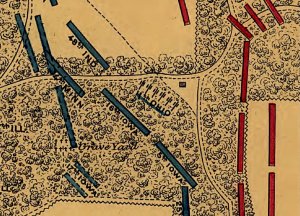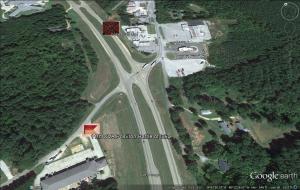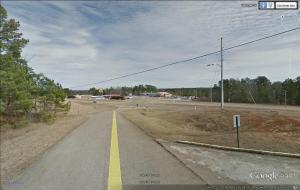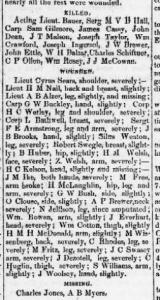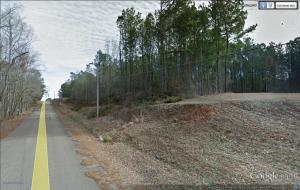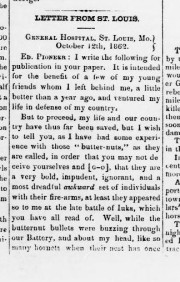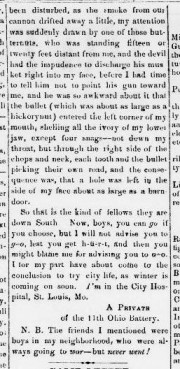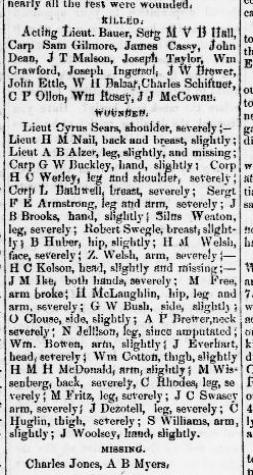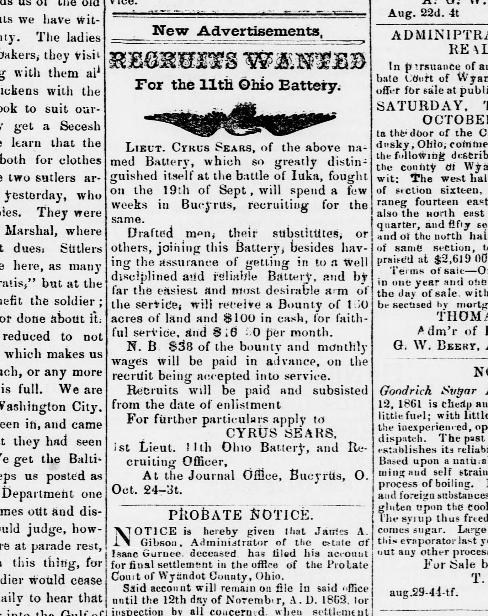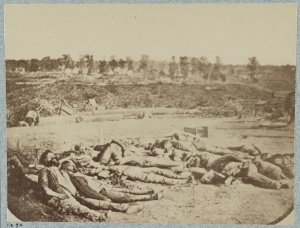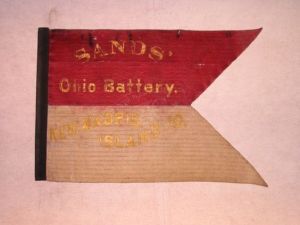A Case for Battlefield Preservation – The Eleventh Ohio Independent Battery – Part 4.
Part three of this series can be found here
As I close out this series on the Eleventh Ohio Battery’s fight at Iuka, I thought it might be interesting to take a look how the battlefield appears today.
First a map of the battlefield as it appeared in 1862:
Next, courtesy of “Google Earth” an aerial view of the Eleventh’s position today:
The following view is what the advancing “Johnnies” would have seen as they charged the Eleventh’s battery position. In the foreground is the Mississippi historical marker describing the Eleventh’s gallant stand.
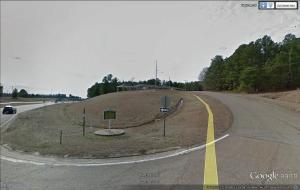 Here is what the “Johnnies” experienced as they advanced up the hill to try to capture the battery:
Here is what the “Johnnies” experienced as they advanced up the hill to try to capture the battery:
“As we ascended the hill we came in range of our own artillery, and the guns had to be silenced. The entire Federal artillery fire was soon turned on us, using grape and canister shot, and as their battery was directly in front of the Third Texas, their grape shot and musketry fire soon began to play havoc with our people, four of our men, the two files just to my right, being killed. We charged the battery, and with desperate fighting took nine pieces and one caisson. The horses hitched to the caisson tried to run off, but we shot them down and took it, the brave defenders standing nobly to their posts until they were nearly all shot down around their guns,—one poor fellow being found lying near his gun, with his ramrod grasped in both hands, as if he were in the act of ramming down a cartridge when he was killed. The infantry fought stubbornly, but after we captured their guns we drove them back step by step, about six hundred yards, when darkness put an end to a battle that had lasted a little more than two and a half hours, the lines being within two hundred yards of each other.
I cannot give the number of Federal troops engaged in the battle, but General Rosecrans, in giving his casualties, enumerates eighteen regiments of infantry, three of cavalry, one detached company, and four batteries of artillery. The cavalry was not in the engagement, and I think he had but two batteries engaged. One of these, the Eleventh Ohio Light Battery, lost its guns and fifty-four men………… The Third Texas had 388 men, and lost 22 killed and 74 wounded; total, 96. Company C lost W. P. Bowers, Carter Caldwell, W. P. Crawley, and W. T. Harris killed; and J. J. Felps severely wounded. Crawley had a belt of gold around his waist, but only four or five of us knew this, and I presume, of course, it was buried with him…….The captured artillery was drawn by hand into town that night, where the guns were left next morning, after being spiked, as we had no spare horses to pull them away. Spiking guns means that round steel files were driven hard into the touch-holes, giving the enemy the trouble of drilling these out before the guns can be of any use again.”
– Excerpt from “Lone Star Defenders. A History of the Third Texas Cavalry Regiment” by Samuel Benton Barron
I wonder how many people today stop to consider the terrible loss of the Third Texas Cavalry (who fought here dismounted) as they charged up the slope in the photo?
Above we have the view from the Eleventh’s Battery position. A look back at the first post in this series describes the horrific fight and gallant stand of the “Buckeyes” of the Eleventh on the slopes in the photo above. But no words compare to reading the names on the list below, and considering the lives lost or lives forever changed here. Not only of those who fell killed or wounded, but the life-long effect of this battle on their families back hone in Ohio.
And, finally, the view of the reverse slope of the hill on which the Eleventh advanced and on whose crest it fought. I believe that it was to the right of the road, just beyond the clearing, that Lieutenant Neil and a few of his surviving battery-men laid sixteen of their neighbors, relatives, and comrades to rest “under a shady tree.” After the war, those men buried here would be moved to the Corinth National Cemetery.
While the Civil War Trust has preserved 58 acres of the Iuka battlefield, much of the core area such as where the Eleventh Battery fought (and died) has been lost forever. As noted in the CWT 2007 History Under Siege Report, when the motel was built on the site of the Eleventh’s stand, it not only changed the character of the land forever, but destroyed many artifacts from the battle.
It is my hope, that by reading this series on the Eleventh Ohio Battery, you have learned a bit about courage, sacrifice and tenacity. All three of these values are reflected in the case of the “Private of the Eleventh Ohio Battery,” Henry Walsh, who managed a hint of humor in his letter home while recovering from a grievous facial wound and the prospect of an uncertain future. And, perhaps, you might be moved enough to consider supporting the Civil War Trust as it leads the charge in the never-ending fight to preserve these precious parcels of ground, made hallow by the blood of our ancestors, and on which so many gave their last “Full Measure of Devotion.”
Sources:
Neil, Henry M. A Battery at Close Quarters. Google Books.
Library of Congress, Chronicling of America, Wyandot Pioneer
Barron, Samuel Benton. Lone Star Defenders. The Guttenberg Project

